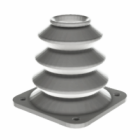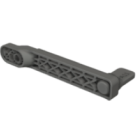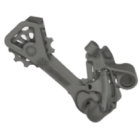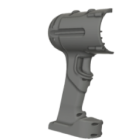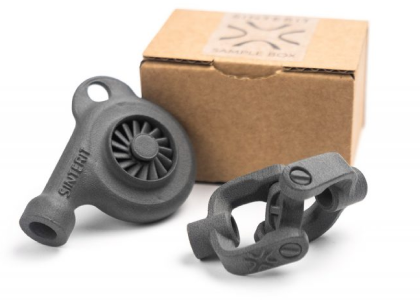What is DMLS and SLM 3D printing? A complete comparison
Metal 3D printing represents the cutting edge of additive manufacturing — not just for prototyping, but for producing end-use, high-performance components. Among the various metal AM technologies, two terms appear most frequently: DMLS (Direct Metal Laser Sintering) and SLM (Selective Laser Melting). While often used interchangeably, these technologies differ slightly in process and application. This chapter explains exactly what is DMLS 3D printing, what is SLM 3D printing, how they work, what materials they use, and how to understand their capabilities in a production context.
How does metal 3D printing work? Step-by-step process
At a fundamental level, both DMLS and SLM are powder bed fusion technologies. They use a high-power laser to selectively fuse metal powder particles together, layer by layer, according to a digital 3D model. A recoating blade spreads a thin layer of metal powder across the build platform, and a laser beam scans the cross-section of the part to melt or sinter the powder in place. The platform then lowers, and a new layer of powder is applied. This cycle repeats until the entire part is built.This process occurs in an inert gas atmosphere (argon or nitrogen) to prevent oxidation, as the raw materials used for SLM 3D printing are extremely reactive at high temperatures. After printing, parts typically undergo stress relief, support removal, and — depending on the application — additional post-processing such as HIP (Hot Isostatic Pressing) or CNC finishing.
DMLS vs SLM 3D printing: key differences and applications
The terms DMLS and SLM describe nearly identical processes, but they originate from different historical and branding paths. Technically speaking, DMLS — a term popularized by EOS — refers to sintering metal particles together, whereas SLM, the full form in 3D printing being Selective Laser Melting, aims for complete melting of the metal powder into a homogeneous structure.
In practice, however, most industrial systems marketed as DMLS today do achieve full melting. The distinction is subtle, but still relevant:
- DMLS is typically used with alloys, where the sintering process helps accommodate varied melting points between elements,
- SLM is often applied to pure metals like aluminum or titanium, which can be fully melted more predictably.
Today, both technologies are functionally similar and equally capable of producing dense, mechanically robust parts.
DMLS & SLM process explained: from CAD to final part
- CAD preparation: the part is modeled with appropriate supports and exported to slicing software.
- Powder layering: a layer of metal powder, usually 20–60 microns thick, is spread across the build plate.
- Laser fusion: a high-power laser (typically fiber-based) fuses or melts the powder where the part geometry exists.
- Layer repetition: the platform lowers, and a new layer is applied and fused — repeating until the build is complete.
- Cooling and post-processing: the part is allowed to cool in the build chamber before being removed, cleaned, and heat-treated.
Materials used in DMLS and SLM metal 3D printing
The raw materials used for SLM 3D printing and DMLS come in the form of fine, spherical metal powders. These powders are manufactured via atomization to ensure flowability and uniform melting behavior.
Common materials include:
- titanium alloys – used in aerospace and medical implants,
- aluminum alloys – lightweight, good thermal conductivity,
- stainless steel – corrosion-resistant and widely applicable,
- inconel – high-performance superalloys for heat and corrosion resistance,
- tool steels – for mold and die applications,
- cobalt-chrome – often used in dental and orthopedic applications.
Material quality is critical in both systems; contamination or poor powder handling can lead to defects, so closed powder management systems and sieving protocols are standard.
DMLS and SLM printing costs: what affects the price?
The DMLS price for parts or systems depends on several factors:
- machine cost: industrial DMLS or SLM machines typically range from €200,000 to well over €1M depending on size, laser count, and automation features,
- material cost: metal powders are expensive — €200–600/kg or more,
- operational cost: inert gas usage, maintenance, and skilled labor contribute significantly,
- post-processing: most metal prints require finishing steps that increase total cost.
Despite these costs, metal 3D printing can be highly economical for high-value, complex, or low-volume parts — especially where traditional machining would be time-consuming or geometrically impossible.
SLS vs SLM vs DMLS: understanding 3D printing technologies
Although they sound similar, SLS, SLM, and DMLS refer to distinctly different technologies. SLS, or Selective Laser Sintering, is a powder-bed fusion method used exclusively for polymers — most commonly nylon — and does not involve metal. In contrast, both SLM (Selective Laser Melting) and DMLS (Direct Metal Laser Sintering) are designed for metal powders and use high-energy lasers to fully melt or sinter material layer by layer. Despite their shared powder-based mechanics, the differences in materials, thermal behavior, and equipment requirements are significant. SLS is generally more accessible and suitable for in-house production environments, as it poses fewer safety and infrastructure demands. Meanwhile, metal printing systems like SLM and DMLS require inert gas handling, advanced ventilation, and dedicated post-processing workflows — placing them firmly in the category of industrial manufacturing solutions.
SLM printing solutions: industry leaders and capabilities
Companies like SLM Solutions, EOS, Renishaw, and 3D Systems have established themselves as leaders in the metal additive manufacturing space. These platforms offer multi-laser systems, closed-loop powder handling, and automated build chamber management — supporting high-throughput production in industries like aerospace, automotive, and medical.
SLM 3D printing technology is no longer limited to R&D; it’s a production-ready solution when part complexity, performance requirements, or supply chain disruption make traditional methods impractical.
Summary: why choose DMLS or SLM for metal 3D printing?
DMLS and SLM 3D printing offer unmatched potential for producing fully dense, high-performance metal parts directly from digital designs. While the terms reflect slightly different origins, both refer to advanced metal powder bed fusion processes that deliver exceptional mechanical properties, design freedom, and production agility.
Whether you’re asking “how do metal 3D printers work?”, “what is DMLS 3D printing?”, or “what is the SLM process in 3D printing?” — the answer lies in controlled, layer-by-layer laser fusion of carefully engineered metal powders in a protective atmosphere. The result is not a prototype — it’s a real, end-use component with performance on par with forged or machined parts.
Explore also
- Overview of 3D printing tech
- What is SLS printing?
- What is FDM 3D printing?
- What is SLA 3D printing?
- MJF 3D printing
- DLP 3D printing
- Binder Jetting
- Material Jetting
- PolyJet printing
- New 3D printing technology
- 3D print vs injection molding
Related categories
 Austria
Austria  Bosnia and Herzegovina
Bosnia and Herzegovina  Bulgaria
Bulgaria  Croatia
Croatia  Czech Republic
Czech Republic  Denmark
Denmark  Estonia
Estonia  Finland
Finland  France
France  Germany
Germany  Greece
Greece  Hungary
Hungary  Ireland
Ireland  Italy
Italy  Latvia
Latvia  Lithuania
Lithuania  Poland
Poland  Portugal
Portugal  Romania
Romania  Slovakia
Slovakia  Slovenia
Slovenia  Spain
Spain  Sweden
Sweden  Switzerland
Switzerland  United Kingdom
United Kingdom  Ukraine
Ukraine  China
China  Hong Kong
Hong Kong  India
India  Israel
Israel  Japan
Japan  Malaysia
Malaysia  Philippines
Philippines  Saudi Arabia
Saudi Arabia  South Korea
South Korea  Taiwan
Taiwan  Thailand
Thailand  Turkey
Turkey  United Arab Emirates
United Arab Emirates  Egypt
Egypt  South Africa
South Africa  Tunisia
Tunisia  Canada
Canada  Mexico
Mexico  United States
United States  Brasil
Brasil  Colombia
Colombia  Australia
Australia  New Zealand
New Zealand 



